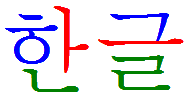|
||||||||||||||||
|
|
|
|||||||||||||||
|
The alphabet: all you need to know before you start studying
Korean script is alphabetic Korean script, like the Latin alphabet, is made up of consonants and vowels. It is therefore an alphabet, and can be learnt very quickly. In Korean, the alphabet is called "Hangeul", 한글. This is the name of the script, and it means "written syllable".
Every hangeul is made of letters. Korean syllables are written in such a way that they can all be confined within a square. The reason is simple: before the invention of this new writing system, Korean was written using Chinese characters, each character being confined in a square.
The structure of Hangul: initial(s), vowel(s) and final(s) Each hangeul is made of initial (consonants), vowels and sometimes finals (also consonants). Due to the shape of certain vowels (one can speak of "vertical" or "horizontal" vowels) they are placed either to the right, or below the initial consonant. Examples of vertical vowels: ㅏ (a), ㅣ (i) Examples of horizontal vowels: ㅗ (o), ㅜ (u) These vowels can be associated with consonants, such as ㄴ (n), to form the following hangeul:
Diphthongs in Korean Nonetheless diphthongs exist in Korean. In this case, the first vowel (which is necessarily a "horizontal" vowel) is first written below the initial (as in 노), and followed by the second vowel (which is necessarily a "vertical" vowel). With the letters studied in the previous examples, we have (let's not worry about the pronunciation right now, and leave that for the next lesson): ㄴ (n) + ㅗ (o) + ㅏ (a) => 놔 ㄴ (n) + ㅜ (u) + ㅣ (i) => 뉘 Syllables including diphthongs can obviously also take finals. For example: ㄴ (n) + ㅗ (o) + ㅏ (a) + ㄴ (n) => 놘 For now, let's not pay attention to whether these phonemes have meanings or not and leave vocabulary to the next lessons ;-) |
||||||||||||||||

 English
English Français
Français Español
Español Português
Português



 Considering that Korean does not only consist of open syllables, but also closed syllables, many Hangeul include (at least) a final. No matter where the vowel is placed in regard to the initial, the final is always written below other jamo in the bottom third. For instance, hangul
Considering that Korean does not only consist of open syllables, but also closed syllables, many Hangeul include (at least) a final. No matter where the vowel is placed in regard to the initial, the final is always written below other jamo in the bottom third. For instance, hangul 

